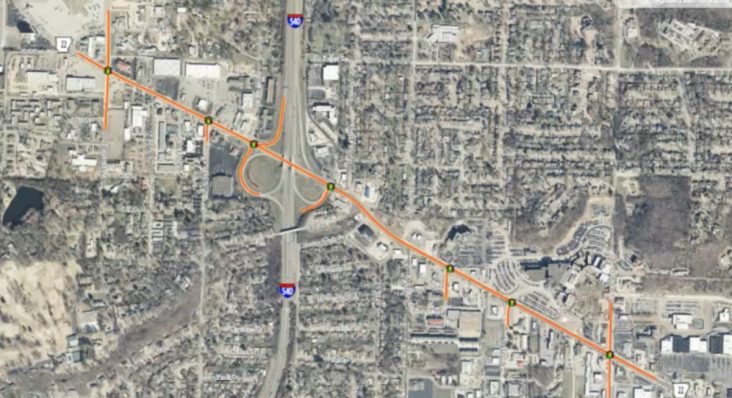ARDOT rep explains planned use of medians on Rogers Avenue project
by September 10, 2024 7:16 pm 1,743 views

Map of planned work along Rogers Avenue in Fort Smith
Representatives from the Arkansas Department of Transportation (ARDOT) told the Fort Smith Board of Directors that the raised medians planned for an improvement project on Rogers Avenue will reduce traffic accidents on the route.
Travis Brooks, ARDOT division engineer with planning and research, addressed the board about the project during a study session Tuesday (Sept. 10) because citizen concerns had been raised about the use of raised medians along the length of the project.
Plans for an up to $20 million project to improve sections of Highway 22 (Rogers Avenue) were shown at a public input meeting May 30 at the Fort Smith Public Library. ARDOT is implementing capacity improvements at the Rogers Avenue/Interstate 540 interchange and along the main lanes of Rogers Avenue in Fort Smith. The improvements will include the construction of a raised median along the main lanes of Rogers Avenue, as well as intersection improvements at various signalized intersections along Rogers Avenue.
The project is scheduled to be let in September 2026. Utilities will be relocated before it is let for contract, Brooks said.
PLANNED IMPROVEMENTS
The improvements will also include widening the road to add capacity to the off-ramps within the footprint of the interchange. There also will be some alignment improvements along several of the left-turn lanes at various signals at intersections along the main lanes of Rogers Avenue.
Brooks said an ARDOT study completed in 2019 found poor peak-hour operation along the corridor, especially during the evening peak hours and exceptionally high crash rates along the corridor. ARDOT looked at whether the completion of Interstate 49 would divert enough traffic from Highway 22.
“They found it would divert some traffic, but it wouldn’t be enough to really change operations,” Brooks said.
Based on the needs study, it was recommended there be major improvements to the corridor, additional travel lanes between 58th and 74th streets and additional access management techniques.
“That basically means different ways to manage types of traffic turning movements,” Brooks said. “It was recommended to add raised medians in order to limit accidents as well as we can and to eliminate those serious crashes.”
The raised medians will be constructed along Rogers Avenue on two segments of the project from Waldron Road to the I-540 interchange and from the interchange to 68th Street, according to ARDOT. The medians are initially designed to be concrete, according to Ellen Coulter, ARDOT media communications manager.
SAFETY FOCUS
The ARDOT study found that compared to similar corridors, this location experiences more than twice the state-wide average of vehicular collisions. Rogers Avenue had more than 1,100 crashes in the corridor from Waldron Road to 74th Street in 2019 to 2023. During that time there were nine fatal or suspected serious injury accidents, Brooks said. Of those more than 500 were rear-end crashes related to congestion and nearly 400 were angel crashes related to turning movements, such as left-hand turns, Brooks said.
Medians, on average, reduce car crashes by 25% and they greatly reduce serious accidents, he said. There were concerns by business owners along Rogers Avenue that the medians would impact customer traffic, Brooks said. The design permits u-turns at select signalized locations across the project area, which allows direct access to abutting properties, he said. U-turns will be available for passenger vehicles, not large trucks such as tractor-trailers, Brooks said.
He said many businesses along Rogers have direct access to a traffic signal or indirect access to a traffic signal via a shared drive or local street, he said. According to national research, the majority of businesses report no change in business activity after a median in construction.
“While a raised median may limit direct access, reducing congestion increases the market area for businesses, it will make it easier to travel the corridor, which will actually improve the market reach,” Brooks said.
There was also concern about emergency vehicles on the corridor with the addition of medians, the decrease in congestion and vehicle accidents, will actually help emergency vehicles, he said. The key to the project was to balance safety, mobility and access, Brooks said.
“More than 40,000 road users will experience safety and mobility benefits each day,” he said.
